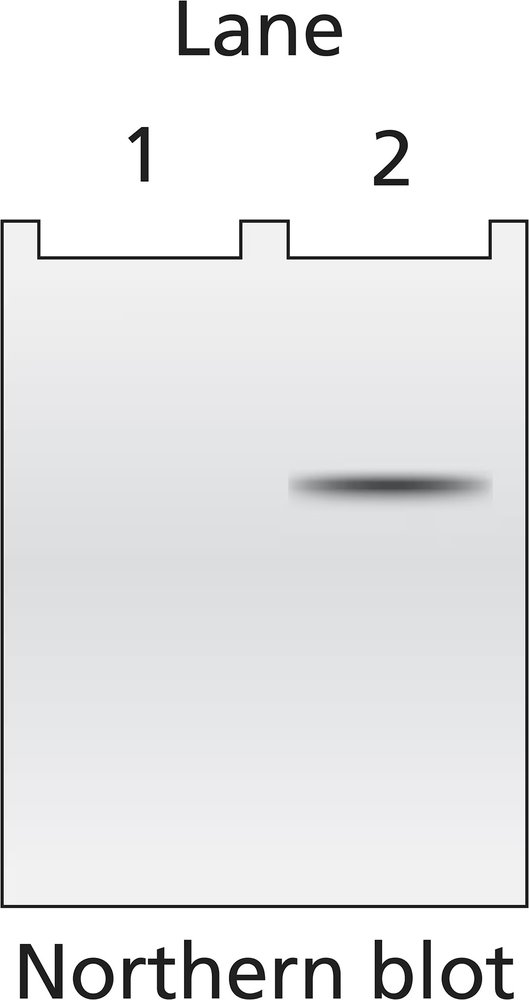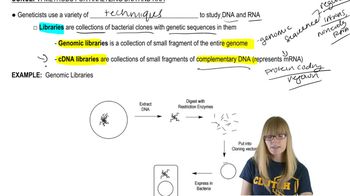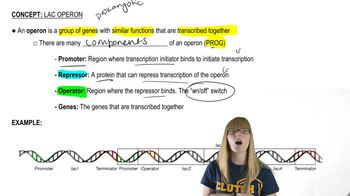The following hypothetical genotypes have genes A, B, and C corresponding to lacI, lacO, and lacZ, but not necessarily in that order. Data in the table indicate whether β-galactosidase is produced in the presence and absence of the inducer for each genotype. Use these data to identify the correspondence between A, B, and C and the lacI, lacO, and lacZ genes. Carefully explain your reasoning for identifying each gene.
Table of contents
- 1. Introduction to Genetics51m
- 2. Mendel's Laws of Inheritance3h 37m
- 3. Extensions to Mendelian Inheritance2h 41m
- 4. Genetic Mapping and Linkage2h 28m
- 5. Genetics of Bacteria and Viruses1h 21m
- 6. Chromosomal Variation1h 48m
- 7. DNA and Chromosome Structure56m
- 8. DNA Replication1h 10m
- 9. Mitosis and Meiosis1h 34m
- 10. Transcription1h 0m
- 11. Translation58m
- 12. Gene Regulation in Prokaryotes1h 19m
- 13. Gene Regulation in Eukaryotes44m
- 14. Genetic Control of Development44m
- 15. Genomes and Genomics1h 50m
- 16. Transposable Elements47m
- 17. Mutation, Repair, and Recombination1h 6m
- 18. Molecular Genetic Tools19m
- 19. Cancer Genetics29m
- 20. Quantitative Genetics1h 26m
- 21. Population Genetics50m
- 22. Evolutionary Genetics29m
12. Gene Regulation in Prokaryotes
Lac Operon
Problem 34d
Textbook Question
Northern blot analysis is performed on cellular mRNA isolated from E. coli. The probe used in the northern blot analysis hybridizes to a portion of the lacY sequence. Below is an example of the gel from northern blot analysis for a wild-type lac⁺ bacterial strain. In this gel, lane 1 is from bacteria grown in a medium containing only glucose (minimal medium). Lane 2 is from bacteria in a medium containing only lactose. Following the style of this diagram, draw the gel appearance for northern blots of the bacteria listed below. In each case, lane 1 is for mRNA isolated after growth in a glucose-containing (minimal) medium, and lane 2 is for mRNA isolated after growth in a lactose-only medium.

lac⁺ bacteria with the genotype I⁻ P⁺ OC Z⁺ Y⁺
 Verified step by step guidance
Verified step by step guidance1
Understand the context of the problem: Northern blot analysis is used to detect specific RNA molecules. In this case, the probe hybridizes to the lacY mRNA, which is part of the lac operon in E. coli. The lac operon is regulated by the presence of glucose and lactose, and the genotype provided will influence the expression of lacY mRNA.
Analyze the genotype I⁻ P⁺ Oᶜ Z⁺ Y⁺: The I⁻ mutation means the repressor protein is nonfunctional and cannot bind to the operator. The Oᶜ mutation (constitutive operator) means the operator is always active, allowing transcription of the lac operon regardless of the presence of lactose. Together, these mutations result in constitutive expression of the lac operon.
Determine the expected mRNA levels in lane 1 (glucose-only medium): In the presence of glucose, catabolite repression typically reduces transcription of the lac operon. However, because of the Oᶜ mutation, the lac operon will still be transcribed at a constitutive level, producing lacY mRNA.
Determine the expected mRNA levels in lane 2 (lactose-only medium): In the presence of lactose and absence of glucose, the lac operon would normally be fully induced. With the Oᶜ mutation, the operon is already constitutively active, so lacY mRNA will be present at high levels.
Draw the gel appearance: For lane 1 (glucose-only medium), expect a visible band corresponding to lacY mRNA, though it may be slightly less intense due to catabolite repression. For lane 2 (lactose-only medium), expect a strong band corresponding to high levels of lacY mRNA. The difference in band intensity reflects the regulatory effects of glucose and lactose on the lac operon.
 Verified video answer for a similar problem:
Verified video answer for a similar problem:This video solution was recommended by our tutors as helpful for the problem above
Video duration:
3mPlay a video:
Was this helpful?
Key Concepts
Here are the essential concepts you must grasp in order to answer the question correctly.
Northern Blotting
Northern blotting is a technique used to detect specific RNA sequences in a sample. It involves the separation of RNA by gel electrophoresis, transfer to a membrane, and hybridization with a labeled probe that binds to the target RNA. This method allows researchers to analyze gene expression by comparing the levels of mRNA in different conditions or treatments.
Recommended video:
Guided course

Methods for Analyzing DNA and RNA
Lac Operon
The lac operon is a set of genes in E. coli that are involved in the metabolism of lactose. It consists of structural genes (lacZ, lacY, and lacA) and regulatory elements that control their expression. The operon is typically activated in the presence of lactose and repressed when glucose is available, illustrating the concept of catabolite repression in bacterial gene regulation.
Recommended video:
Guided course

Lac Operon Overview
Gene Expression Regulation
Gene expression regulation refers to the mechanisms that control the timing and amount of gene product (RNA or protein) produced in a cell. In the context of the lac operon, the presence of glucose inhibits the expression of genes necessary for lactose metabolism, while lactose induces their expression. Understanding these regulatory mechanisms is crucial for interpreting results from experiments like northern blotting.
Recommended video:
Guided course

Penetrance and Expressivity
Related Videos
Related Practice
Textbook Question
490
views


